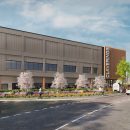
SBY Real Estate: From Fabrication to Fulfilment: The Blurring Lines of Inner London’s Industrial Market

SBY Real Estate, Industrial and Logistics specialists, discuss the blurring lines of inner London’s Industrial Market

SBY are marketing 11,302-133,500 sq ft at Claverings Edmonton, a prime urban-logistics hub, on behalf of Danescroft/Fiera
As e-commerce surges, land values rise, and policy pushes intensification, inner London’s industrial market is evolving fast. Once clearly separated, last-mile logistics and traditional light industrial uses are now increasingly competing – and converging – in urban locations. This shift presents challenges for occupiers and developers alike, but also a moment of opportunity.
What Defines Urban Logistics vs Light Industrial?
At their core, last-mile logistics facilities are designed to fulfil the final stretch of the delivery process – from warehouse to doorstep – with rapid turnover, high throughput, and growing pressure for same-day delivery. These assets thrive in dense, residential areas within 3-5 miles of consumer hotspots, prioritising immediate access, generous yards, and increasingly, EV-charging infrastructure.
Meanwhile, light industrial units are typically used for small- to medium-scale production, trade counters, storage, and fabrication. In London, these have historically served localised supply chains and SMEs, with occupiers placing more weight on access to workforce, suppliers, and flexible, adaptable space.
But today, those differences are starting to blur.
The Squeeze: Land Pressure and Functional Overlap
London has lost around 18% of its industrial land since 2001 – a trend driven by residential development, transport upgrades, and mixed-use regeneration. Many boroughs have intensified land-use designations through Opportunity Areas and Site Allocations policies, with industrial space either co-located, relocated, or removed altogether. Despite policy intentions to protect Strategic Industrial Land (SIL), inner boroughs remain under acute supply pressure.
Sites seen over the past couple of years, such as Morden Wharf on the Greenwich Peninsula, reflect a growing trend. Galliard Homes acquired the site outright in 2023, securing permission for 1,500 residential units alongside approximately 90,000 sq ft of B2 and B8 warehousing space, and are now partnering with a specialist logistics developer. This model – where industrial uses are retained and delivered as part of wider mixed-use regeneration – is likely to become increasingly common across inner London, creating new opportunities for logistics developers to collaborate with residential-led schemes.
This has pushed logistics occupiers into locations once dominated by light industrial users – places like Battersea, Camberwell and Southwark, which offer a blend of density, infrastructure, and site flexibility. In these areas, urban logistics and light industrial are now competing side by side for limited space – both in terms of location and the physical buildings themselves.
A Developer’s Response: Going Upwards
To tackle land scarcity, developers have increasingly embraced multi-storey and multi-level warehouse formats. At Bloom Camberwell, for example, institutional-grade space is spread across multiple levels, with quoting rents of £40 psf – reflecting both premium location and functionality.
Traditionally, mezzanine floors were more common in light industrial schemes, supporting production or admin uses. However, we’re now seeing mezzanines used to increase density in logistics-oriented builds – especially where operators can accommodate sortation, returns, or light assembly functions across levels.
Urban developers are also prioritising EV infrastructure, 24/7 access, and delivery diversity, including provision for cargo bikes, scooters, and electric vans – features now relevant to both logistics and hybrid industrial occupiers.
JD.com: Blending Urban Reach with Regional Scale
A clear example of this hybrid strategy is JD.com, one of the most active industrial occupiers in the UK today. In the Big Box sector, the company has recently secured 531,519 sq ft at PLP Milton Keynes and 117,076 sq ft at Ansty Park, Coventry – part of a wider pivot from the US to European logistics networks in light of trade and tariff shifts.
But JD.com isn’t just going big. In Greater London, they’ve also completed 12 lettings of around 5,000 sq ft each between May and June 2025, as they scale up their last-mile distribution capacity. Additional regional activity is expected this year, particularly in locations such as Corby and Lutterworth.
This dual-logistics model – regional hubs supporting a wide network of urban units – highlights the growing interdependence between light industrial and logistics property. For developers and investors, it’s a sign that future-proofed schemes must serve multiple operational needs.
Policy and Planning: Still Catching Up?
While the London Plan and borough-level policies encourage intensification, the market has often outpaced policy in recognising the distinct spatial and operational requirements of logistics vs light industrial users.
Co-location schemes, where industrial uses are placed beneath residential or office developments, can suit light industrial occupiers – particularly those with less vehicle dependency. But logistics operators typically need unfettered 24/7 access, high vehicle turnover, and generous yard space – needs not always compatible with residential neighbours or constrained footprints.
That said, pioneering schemes such as The Box in Paddington – featuring high eaves, HGV access and cargo bike infrastructure, all beneath a 13-storey office – show how thoughtful design and intensification can successfully accommodate urban logistics at the heart of the city.
A Resilient Bet: Where Occupier Flexibility Meets Capital Growth
Both asset types offer compelling investment fundamentals:
– Ongoing demand from logistics, e-commerce and trade occupiers
– Intensifying rental growth due to restricted land supply
– Multiple paths to reversion through lease events and redevelopment
– Increasing appetite for sustainable, future-ready space
But the smart money is now on flexible buildings in flexible locations – assets that can cater to a mix of occupier types and evolve as needs change.
Conclusion: Where the Sectors Meet, Opportunity Follows
The fusion of last-mile logistics and light industrial isn’t just a trend – it’s a structural market shift. Occupier expectations, policy constraints, and urban land values are pushing these once-distinct asset classes toward shared territory – literally and figuratively.
For developers and investors, the key will be delivering multi-functional, densified, and sustainably designed space that can accommodate everything from van-based fulfilment to fabrication and trade use. As operators like JD.com show, the future of logistics is not just big and centralised – it’s local, agile and interconnected.
You can see all of the available commercial property from SBY Real Estate on NovaLoca here.
